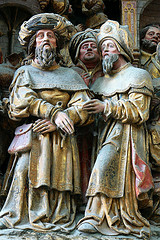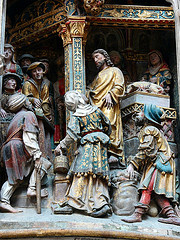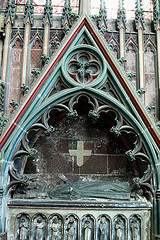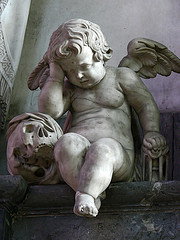Notre-Dame d'Amiens

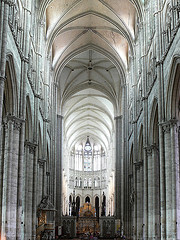 The cathedral of Notre-Dame in Amiens was mostly constructed out of limestone, the relatively short timespan of its construction between 1220 and 1236 accounts for its uniformity of architectural design. The nave vaulting is 42.30 and the spire rises 112.7m above the ground making Amiens the tallest completed Gothic church and largest cathedral in France, vault of the nave of the incomplete Beauvais Cathedral is higher at 48m but the roof suffered three collapses and was never finished. The interior length is 133.5m and that of the transepts 62m.
The cathedral of Notre-Dame in Amiens was mostly constructed out of limestone, the relatively short timespan of its construction between 1220 and 1236 accounts for its uniformity of architectural design. The nave vaulting is 42.30 and the spire rises 112.7m above the ground making Amiens the tallest completed Gothic church and largest cathedral in France, vault of the nave of the incomplete Beauvais Cathedral is higher at 48m but the roof suffered three collapses and was never finished. The interior length is 133.5m and that of the transepts 62m.
The Romanesque cathedral had been destroyed by fire in 1218, and Bishop Evrard de Fouilly employed Robert de Luzarches as the architect to build the new cathedral in the Gothic style to house the head of Saint John the Baptist which had been bought back as a relic by Wallon de Sarton returning from Constantinople in 1206 after the fourth crusade; and for the body of St Firmin, the first bishop of Amiens, who was reputed to have established Christianity in Northern France. The cathedral was designated a UNESCO World Heritage Site in 1981 for the coherence of its plan, the beauty of its three-tier interior elevation.
The western façade of the cathedral consists of three portals, or doorways. the central portal contains a Tympanum of the Last Judgement, the south portal is dedicated to the Vigin Mary, and the north portal to St Firmin. Amiens is also the birth-place of Peter the Hermit, who according to Matthew Paris and Roger of Wendover, was the originator of the first Crusade.
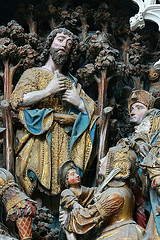
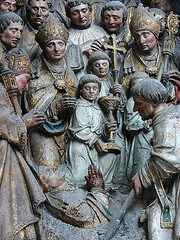 The ambulatory around the choir has polychromatic reliefs depicting on the north side, scenes from the life of John the Baptist, and on the south side, scenes from the life of St Firmin (Fermin), who according to legend was a 3rd century convert to Christianity and the 1st bishop of Amiens. These sculptures were commissioned by canon Adrien de Hénencourt (d1530), and were constructed between 1490 and 1530.
The ambulatory around the choir has polychromatic reliefs depicting on the north side, scenes from the life of John the Baptist, and on the south side, scenes from the life of St Firmin (Fermin), who according to legend was a 3rd century convert to Christianity and the 1st bishop of Amiens. These sculptures were commissioned by canon Adrien de Hénencourt (d1530), and were constructed between 1490 and 1530.
In the transepts there are also polychromatic reliefs showing in the south transept the story of St James the Greater's conversion of Philetus and Hermogenes (1511), and in the north transept Jesus purging the temple of the moneylenders (1523).
The Cathedral has surviving tombs from the 13th to 16th century, including that of Canon Thomas de Savoie (d1334) with 8 weepers around the base.
Near by, and above the tomb of Cardinal Jean de la Grange (d1402) is the Weeping Angel by Nicolas Blasset, made famous during the First World War when soldiers sent postcard images of it back home.

